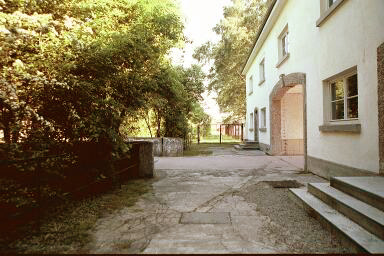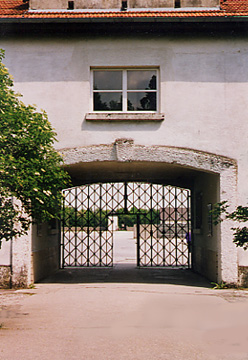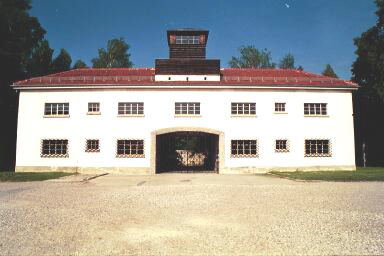The gatehouse into Dachau prison compound
Prisoners were brought to the Dachau concentration camp from
the railroad station in the Lower Town of Dachau. Most of them
had to walk to the camp along Friedenstrasse (Freedom Street)
which paralleled the railroad spur line that ran from the station
to the SS camp. When the prisoners reached the SS camp, they
had to first go through a gate on the southwest side of the SS
complex, then walk east to the main gatehouse which was on the
south side of the complex. After walking a short distance along
a road with factories on each side, the prisoners turned right,
then crossed a bridge over the Würm river and entered the
prison compound through the gatehouse shown in the photograph
below. On the left you can see the concrete barriers on the sides
of the bridge over the Würm river. An old photograph, taken
when the camp was in operation shows the street in front of the
bridge which is
currently closed off by a wall, so that visitors do not have
access to the former SS camp.


Entrance into prison compound through gatehouse
The photograph above was taken in May 1997. The trees that
you see on either side are now so overgrown that it is difficult
to get a good picture. The Memorial Site is currently being modified
and by 2003, the wall (behind the camera) in front of this gate
will be gone. The new tourist entrance will be through the gatehouse,
so visitors can relive the experience of the incoming prisoners.
This gate is a 1965 reconstruction of the original gate, which
was built by a prisoner named Karl Röder. It was removed
by the American army after the camp was liberated. The slogan
"Arbeit Macht Frei" was coined by Propaganda Minister
Josef Goebbels in an effort to convince the public that the Nazi
concentration camps were merely work camps to rehabilitate criminals,
asocials, homosexuals and Communists. This slogan was first used
over the gate of the camp at Oranienberg, just outside Berlin.
The gatehouse at Sachsenhausen also bears this inscription, but
the third major German concentration camp, Buchenwald, has a
sign on the gate that reads "Jedem das Seine," which
means To Each his Own. Buchenwald was a Class II camp, while
Dachau was a Class I camp for offenders who were considered capable
of being rehabilitated and then released. Rudolf Höss, who
trained at Dachau and then served as an adjutant at Sachsenhausen
before becoming the first Commandant at Auschwitz, used this
motto over the gate into the main camp, Auschwitz I, which was
classified as a Class I camp. (Auschwitz II also known as Birkenau
was not a Class I camp, and no one was ever released from there;
Birkenau did not have this slogan over the gatehouse.) Mauthausen
in Austria was the only Class III camp, where prisoners, who
were considered beyond rehabilitation, were treated very harshly.
On the right side of the photograph below, you can see the
west wing of the service building. After the incoming prisoners
entered the gate, they were taken to the west wing for registration.
By 2003, visitors will follow the same route as the prisoners,
going first to new exhibits in the west wing of the service building.
The west wing has been off limits to visitors ever since the
camp was liberated.

Sign on gate means "Work brings freedom"
The original gate was designed to open from top to bottom
to allow vehicles or a group of prisoners to enter. It was secured
by bolts which had to be removed to open the gate. It also had
a pedestrian gate with a lock that could only be released by
remote control from inside the building. The reconstructed gate
is left unlocked for visitors.
The photograph below shows the gatehouse building from inside
the camp. The official name for this building is Dienstgebäude,
which means duty house, but it was always called the Jourhaus.
The building was completed in June 1936. It replaced a wooden
building that was used before the Dachau camp was completely
rebuilt. The Buchenwald camp near Weimar and the Sachsenhausen
camp near Berlin both have a gatehouse modeled after this one.
The guard tower at the top of the building was called Tower A.
Entrance to the tower was through the building. A machine gun,
behind a sliding glass window, was trained on the prisoners in
the camp, ready to fire in case of a prison riot or disturbance.

Gatehouse had machine gun in watch tower on top

|



